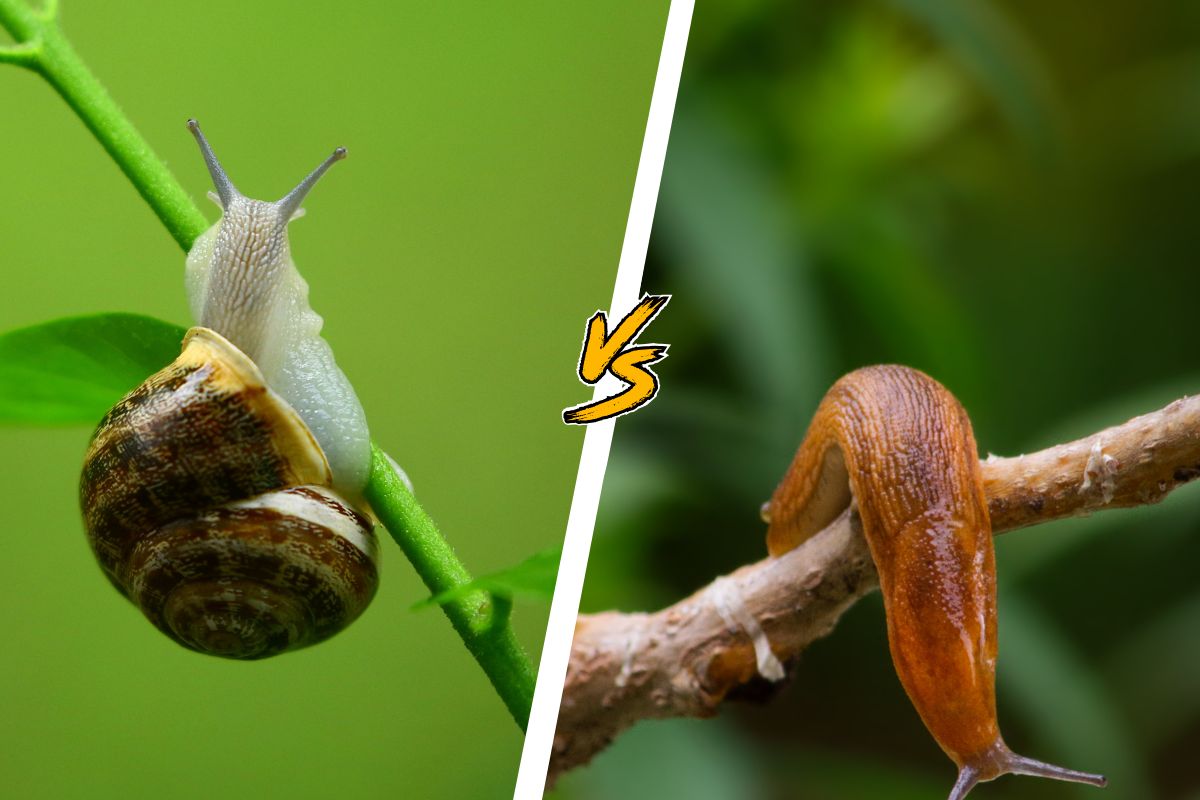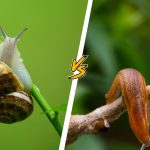You’ve probably spotted both creatures in your yard. You might have seen them after a rainy day or curled up under a flowerpot. At first glance, a slug and a snail look nearly identical. They move at the same slow pace, are slimy, and both feed on plants. But they are quite different.
If you’ve ever asked yourself what separates them, this article is for you. Therefore, let’s start.
First Things First – The Shell
The biggest and most obvious difference? The shell. snail carries a spiral shell on its back. The shell is firm, coiled, and grows along with the animal. When danger approaches, the snail can retreat inside for protection. Picture it like a tiny camper folding into a sturdy tent.
A slug has no shell at all. Some types of slugs have a tiny internal plate inside their bodies, but you can’t see it from the outside. They look like soft, long blobs that slide along the ground.
That shell is the reason many people find snails a bit cuter or easier to handle. Slugs? Not so much.
Where Do They Live?
Snails seek damp spots but also look for cool cover when the heat kicks in. Their shell acts like a mini tent. You can spot them in gardens, wedged under leaves, along stone paths, or stuck on walls on cooler days.
Slugs crave moisture even more. They don’t have a shell, so they dry out much more than snails. So they curl up in shady hiding places- under flowerpots, rocks, lumber stacks, or deep in loose soil.
Both come out in the open when it rains or the soil feels soggy. Drought and sun drive them back into hiding. No one likes to dry out, especially if your whole body is made of soft tissue.
What Do They Eat?
They both eat plants. Leaves, flowers, fruit, vegetables—you name it. In the garden, they’re not exactly friends of the plants.
Snails usually eat soft plant material. But slugs can chew through a bit more. Some slugs even eat fungi, compost, and other slugs. Yeah, really.
If you grow lettuce or strawberries in your backyard, you’ve probably seen the damage they leave behind. They leave behind big holes in leaves, nibbled edges, and shiny trails.
Some people call them garden pests. But they’re also part of the ecosystem. Birds, frogs, and even some beetles eat them.
How Do They Move?
Both slugs and snails move by sliding along on a single flat foot. That foot oozes slime, or mucus, which cushions every glide and shields tender skin from jagged bits of gravel.
That’s why you find a shiny trail stuck to the ground after they pass. The trail helps them slide and keeps their body from drying out.
They’re slow, for sure. But not lazy. They can actually travel far distances (for their size) if they need to. Just don’t expect them to win any races.
Are They the Same Inside?
At first glance, slugs and snails look like twins, but their insides tell a different story.
Because snails carry a shell, their body is coiled and protected. Most organs nestle inside that spiral shell., The shell even stores extra calcium, a bonus that helps snails grow and repair damage.
Because slugs don’t carry a bulky shell, their bodies can take on all kinds of shapes. Some researchers even argue that slugs squeeze through tighter gaps than snails since they don’t have that big shell to carry around.
Which One Lives Longer?
Snails usually win the longevity contest. A common garden snail lives about five to seven years in the wild, and even longer in a sheltered yard or terrarium. Slugs, by contrast, average only one to two years. They do not have a shell for protection, so they face more danger from hungry birds, rain, and sudden cold snaps.
Why People Often Mix Them Up
It’s easy to mix them up. They both move slowly. They both show up after rain. And they both like leafy greens.
But if you look closely, it’s not that hard to tell the difference. That shell is the giveaway. Still, many people say “slug” when they mean “snail” or the other way around. Even kids in school sometimes get them confused.
Are They Harmful?
Not to humans, really. Most slugs and snails are harmless unless you eat raw veggies with their slime on it. That’s why it’s good to wash lettuce well.
In gardens, though, they can be a real problem. Some people use eggshells, coffee grounds, or special garden traps to keep them away from plants.
Still, they play a role in nature. They help break down dead plants and add nutrients to the soil.
Final Thoughts
Slugs and snails might not be the stars of the animal world, but they’re worth knowing about. The biggest difference? Snails have shells. Slugs don’t.
Snails are a little better protected and live longer. Slugs can squeeze into smaller places and sometimes eat more kinds of stuff.
Next time you’re in the garden and see one sliding across the ground, take a second look. Shell or no shell—you’ll know which one it is. And if a kid runs up with a “tiny snake,” well, now you’ll know exactly what to say.











